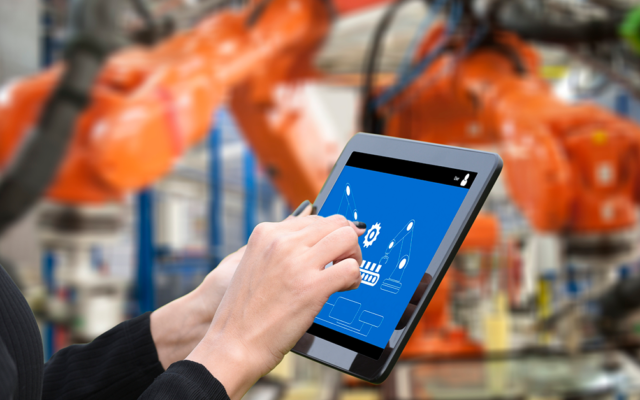Manufacturers are embarking on a digital transformation journey. To transform, their business must consider the role of IoT and the connected ecosystem.
In order to compete and thrive, companies will need to fundamentally change the way they engage with their customers, improve efficiency and cost savings, engage with their teams and employees, and manage data-driven initiatives.
The people who build advanced industrial technologies and automate existing processes are at the center of this transformation journey. They will ultimately become the greatest asset for these digital manufacturers.
IoT, ML, AI are part of an ecosystem, not just buzz words
Machine learning can help manufacturers to implement IoT systems at a cost-effective and scalable rate. For example, an IoT system on an end-to-end manufacturing chain can detect any change in the production process, identify incremental expenses that can be avoided and link their data with production audits. This can lead to increased operational efficiencies and operational effectiveness.
IoT brings automation in areas where traditional automation is not possible and lacks productivity, such as remote locations and long production lines, thus helping companies differentiate their processes to help improve the cost of doing business.
Leadership begins at the top
For automation to have a profound impact on industry, a company’s management must evaluate, understand and execute a strategic transformation process that aims to turn its existing capabilities into more strategic enterprises. The top priority is to decouple technology and human capital.
IoT is transforming how complex manual processes are automated and optimized. The new skillset gap is also critical, as manufacturers are embracing the need to bridge automation to critical job functions. And organizations are leveraging the new cloud-enabled platforms to drive business velocity.
Access to infrastructure and software development is based on diversity of skill sets and maturity of skills across business functions.
Automation projects are pervasive, but not fully successful yet
According to a study from Microsoft, “85 per cent of decision-makers have adopted IoT, and 74 per cent have projects in the ‘use’ phase.” With so many businesses now looking to adopt IOT in an effort to increase productivity and profitability, machine learning and artificial intelligence are shaping the industry into a more tech-led, strategic machine.
While AI will shape a vast number of industries in the coming years, one segment that is still in dire need of new technologies is manufacturing. Part of the reason might come from low IoT project success rates. According to Cisco, only a quarter of IoT initiatives are actually successful.
But here is the good news: machine learning and AI are flexible and can adapt. Trained machine learning specialists can extract the most out of machine learning algorithms.
Additionally, the technology requires relatively low capital investments and labor inputs. A small team of engineers working deploying cloud-based ML and AI can accomplish amazing things.
Not to mention that machine learning and AI have quickly become a natural fit with the manufacturing environment. Manufacturers can easily monitor the machines and systems they control, altering their software and hardware to introduce machine learning to their operations. The end result is an effective way to speed up the time it takes to make a product — a manufacturing skill that holds many benefits.
But wait, there’s more
The advantages of machine learning and AI do not stop with streamlined processes. Companies, especially those who are still transitioning to new technologies, can also now enter the industry’s lucrative IoT market.
As factories invest in automation and IoT to extend their resources and productivity, the bottom line will benefit. By utilizing machine learning and AI to digitally automate the process, more companies can come out ahead in the development of their own competitive advantages.
To do this, digitization is designed into business models, products and systems to act on this new type of data. Yet the way to market is filled with challenges – products that are too complex, data fragmentation, and limited visibility. An under-developed research landscape is also a significant hurdle for manufacturers working in the digital realm.
But the more “smart” a facility is, the better it will be at optimizing real-time physical output and learning from its operations while minimizing operations costs.
Hence a multi-channel digital transformation, integrated over all functions of the organization (including hardware, software, manufacturing, business processes, safety, logistics, quality, and human factors) can drive significantly higher improvements.
An organization, with the intent to reduce costs and maintain its excellent quality through digital transformation, should be focused on automation of the physical environment, as well as on content management and customer relationship management via digital transformation.
Doing so lets the company apply technology to benefit from advances in data science, machine learning and various algorithms, which lead to improved security, better inventory management and more efficient operations.
Digital factories are inevitable. Are you?
Machine learning offers a lot of opportunity and insight for companies in the industrial market. That’s because machine learning can reduce some of the most significant input-output bottlenecks and simplifies business processes. These limits make IoT a catalyst for digital transformation initiatives.
Companies face intense pressure to transform their global businesses as the digital revolution becomes more pervasive, allowing competitors to do more with fewer resources.
Companies that resist the use of digitization are being left behind. The way to equip employees for an IoT future to ensure that they are at the center of its development.
Article by channel:
Everything you need to know about Digital Transformation
The best articles, news and events direct to your inbox
Read more articles tagged: Automation, Featured







